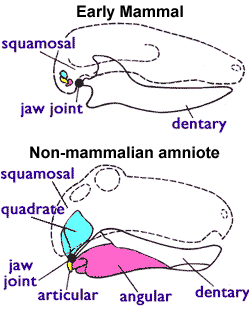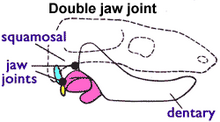Articular bone
Appearance
This article may require cleanup to meet Wikipedia's quality standards. The specific problem is: Incorrect information. (March 2015) |
The articular bone is part of the lower jaw of most vertebrates, including most jawed fish, amphibians, birds and various kinds of reptiles, as well as Stem-mammal. In these animals it is connected to two other lower jaw bones, the suprangular and the angular. It forms the jaw joint by articulating with the quadrate bone of the skull.


One theory is that in mammals, the articular bone has migrated to the middle ear to become the malleus, while the quadrate bone becomes the incus. Paleontologists regard this differace as the defining characteristic of mammalian fossils.[2]
